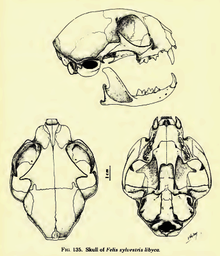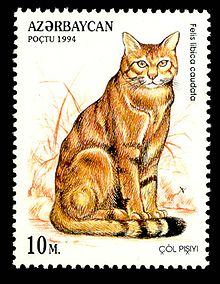- African Wildcat
-
African Wildcat[1] 
Scientific classification Kingdom: Animalia Phylum: Chordata Class: Mammalia Order: Carnivora Family: Felidae Genus: Felis Species: F. silvestris Subspecies: F. s. lybica Trinomial name Felis silvestris lybica
Forster, 1770The African wildcat (Felis silvestris lybica), also known as the desert cat, and Vaalboskat (Vaal-forest-cat) in Afrikaans, is a subspecies of the wildcat (F. silvestris). They appear to have diverged from the other subspecies about 131,000 years ago.[2] Some individual F. s. lybica were first domesticated about 10,000 years ago in the Middle East, and are among the ancestors of the domestic cat. Remains of domesticated cats have been included in human burials as far back as 9,500 years ago in Cyprus.[3][4]
Contents
Physical characteristics
The African wildcat is sandy brown to yellow-grey in color, with black stripes on the tail. The fur is shorter than that of the European subspecies. It is also considerably smaller: the head-body length is 45 to 75 cm (17.7 to 29.5 inches), the tail 20 to 38 cm (7.87 to 15 inches), and the weight ranges from 3 to 6.5 kg (6.61 to 14.3 lbs).
Distribution and habitat
The African wildcat is found in Africa and in the Middle East, in a wide range of habitats: steppes, savannas and bushland. The sand cat (Felis margarita) is the species found in even more arid areas.
Behaviour
The African wildcat eats primarily mice, rats and other small mammals. When the opportunity arises, it also eats birds, reptiles, amphibians, and insects. The cat approaches its prey slowly, and attacks by pouncing on its prey as soon as it is within range (about one metre). The African wildcat is mainly active during the night and twilight. When confronted, the African wildcat raises its hair to make itself seem larger and intimidate its opponent. In the daytime it usually hides in the bushes, although it is sometimes active on dark, cloudy days. The territory of a male overlaps with that of a few females, who defend the territory against intruders. A female gives birth to two to six kittens, with three being average. The African wildcat often rests and gives birth in burrows or hollows in the ground. The gestation lasts between 56 and 69 days. The kittens are born blind and need the full care of the mother. Most kittens are born in the wet season, when there is sufficient food. They stay with their mother for five to six months and are fertile after one year.
Subspecies origin
Based on a mitochondrial DNA study of 979 domestic and wild cats from Europe, Asia, and Africa, Felis silvestris lybica split off from the European wildcat about 173,000 years ago and from the Asian subspecies F. s. ornata and F. s. cafra about 131,000 years ago. About 10,000 years ago, some Felis silvestris lybica individuals were domesticated in the Middle East. Modern domestic cats are derived from at least five "Mitochondrial Eves". None of the other subspecies of Felis silvestris contributed to the domestic breed, and many of those subspecies' own mtDNA is being swamped by interbreeding with feral cats.[2] The only organization currently known to have a program specifically aimed at conserving African wildcats and reducing genetic pollution by domestic cats is Alley Cat Rescue.
In philately
The Libyan Posts (General Posts and Telecommunications Company, GPTC) in cooperation with World Wide Fund for Nature, dedicated a postage stamps issue to Felis lybica on November 1, 1997. The issue was made of a set of four stamps printed in minisheet with two sets.[5]
References
- ^ Wozencraft, W. Christopher (16 November 2005). "Order Carnivora (pp. 532-628)". In Wilson, Don E., and Reeder, DeeAnn M., eds. Mammal Species of the World: A Taxonomic and Geographic Reference (3rd ed.). Baltimore: Johns Hopkins University Press, 2 vols. (2142 pp.). pp. 536-537. ISBN 978-0-8018-8221-0. OCLC 62265494. http://www.bucknell.edu/msw3.
- ^ a b Driscoll, Carlos A.; Menotti-Raymond, Marilyn; Roca, Alfred L.; Hupe, Karsten; Johnson, Warren E.; Geffen, Eli; Harley, Eric H.; Delibes, Miguel et al. (1997), "The near eastern origin of cat domestication", Science 317: 519–523, doi:10.1126/science.1139518, PMID 17600185, http://www.sciencemag.org/cgi/content/abstract/1139518.
- ^ Kingdon, Jonathan (1988), East African Mammals: Carnivores, University of Chicago Press, ISBN 0-226-43721-3.
- ^ Wade, Nicholas (June 29, 2007), Study Traces Cat’s Ancestry to Middle East, New York Times, http://www.nytimes.com/2007/06/29/science/29cat.html, retrieved 19-Apr-2010.
- ^ Libyan Stamps online
External links
Categories:- Felis
- Animals described in 1770
- Mammals of Africa
- Mammals of Kenya
- Mammals of Southwest Asia
Wikimedia Foundation. 2010.


